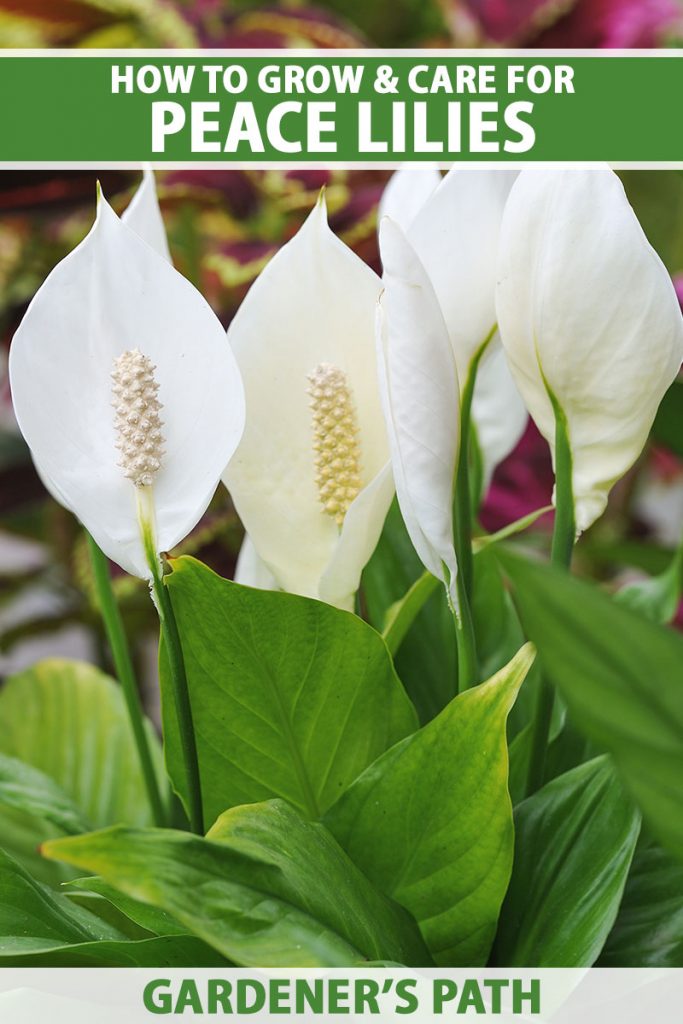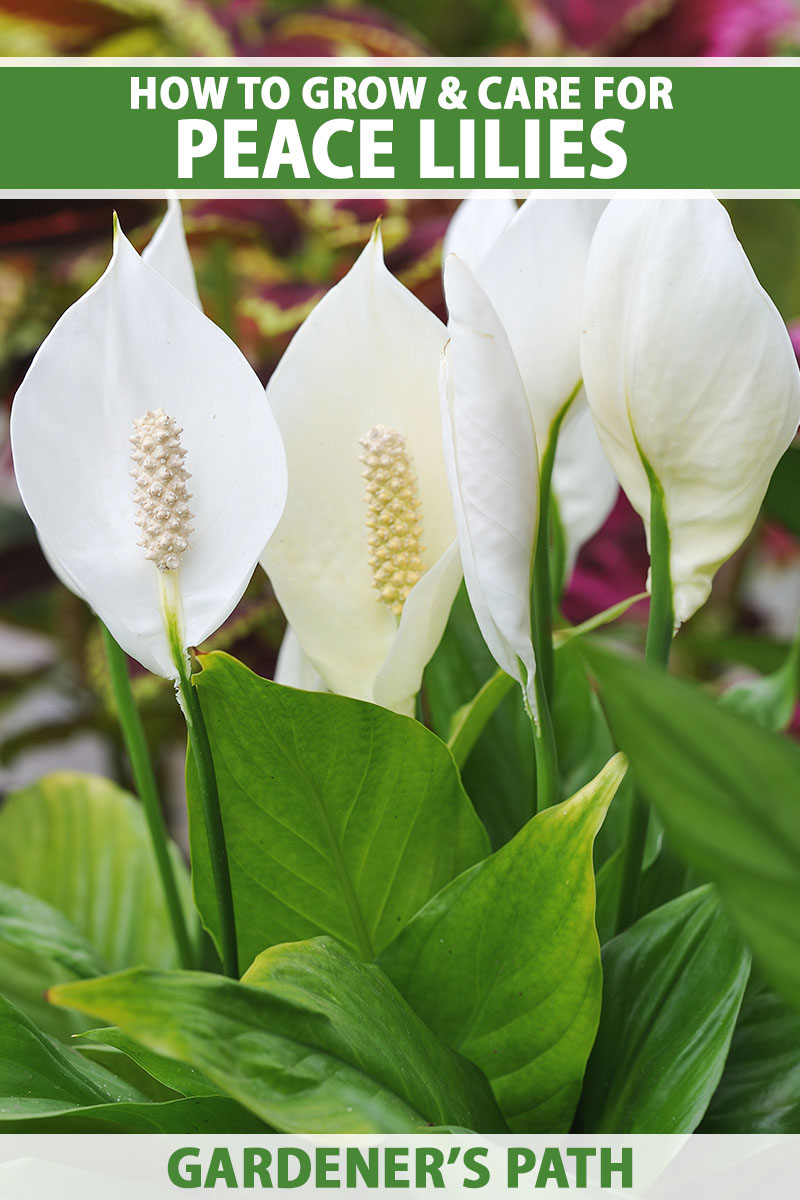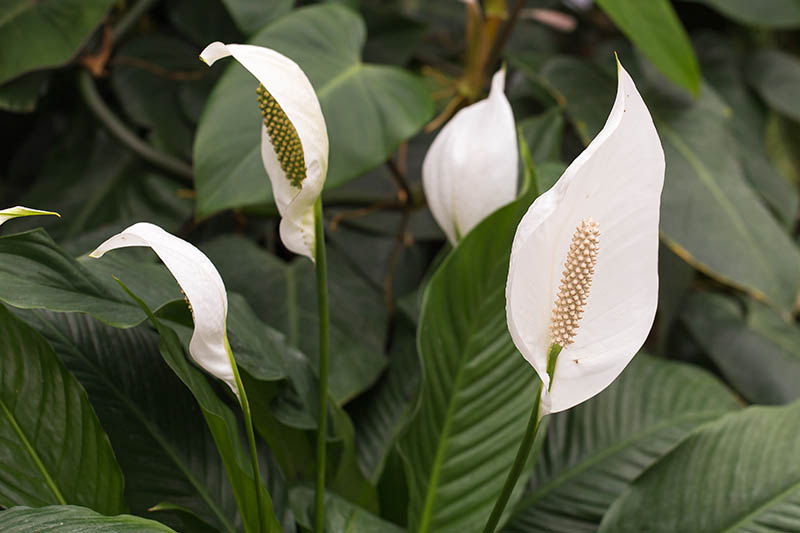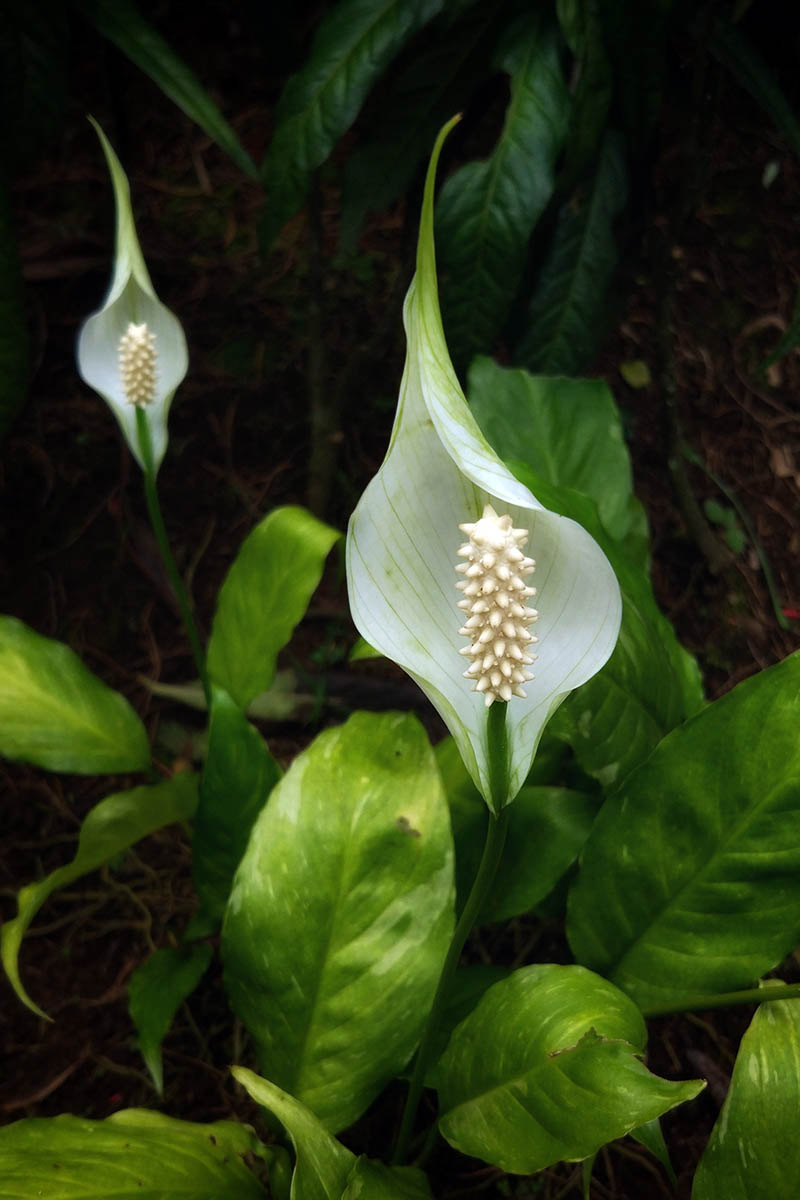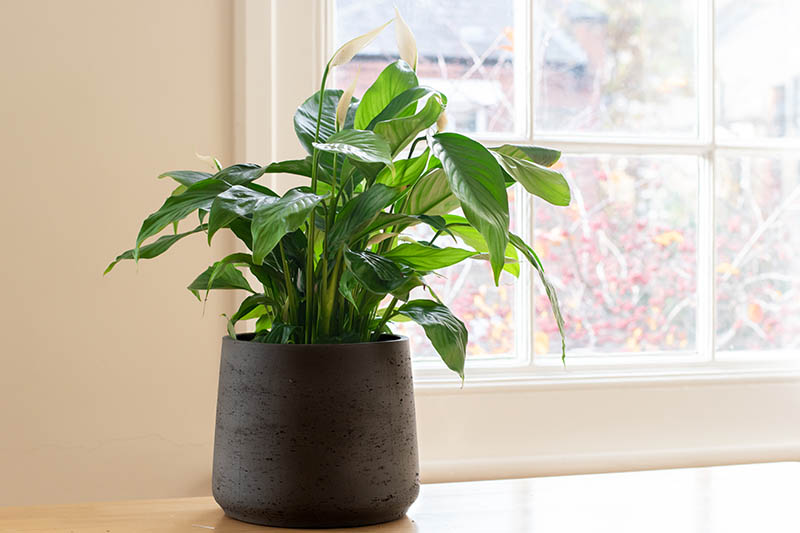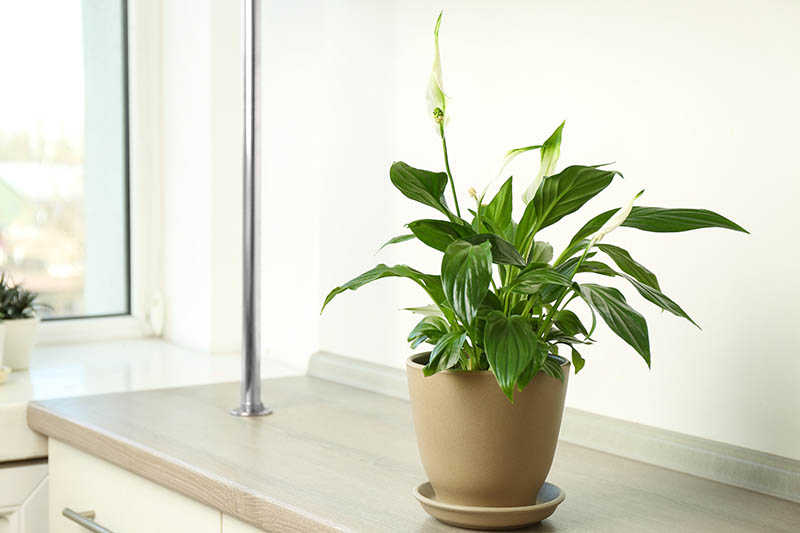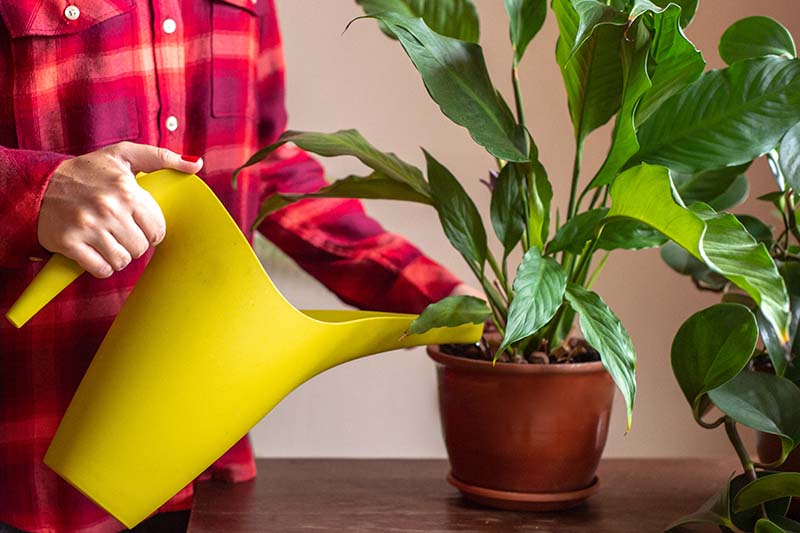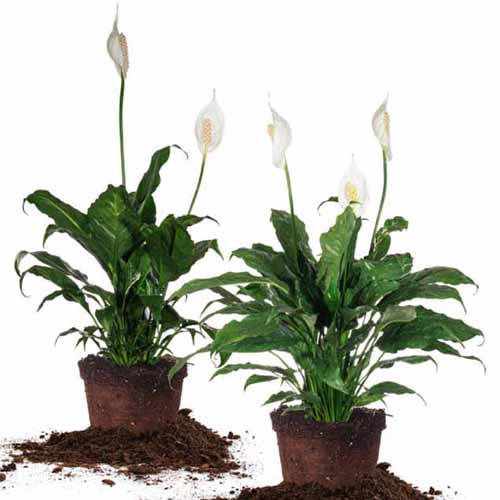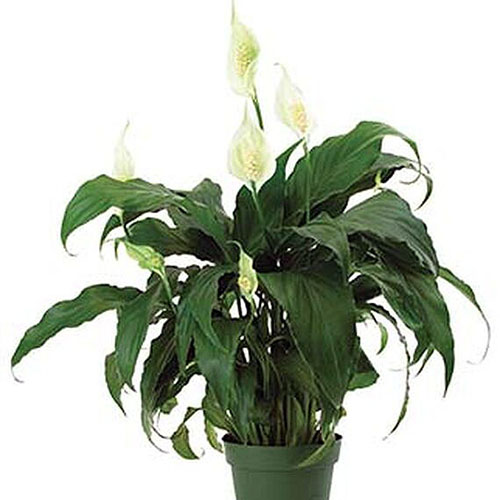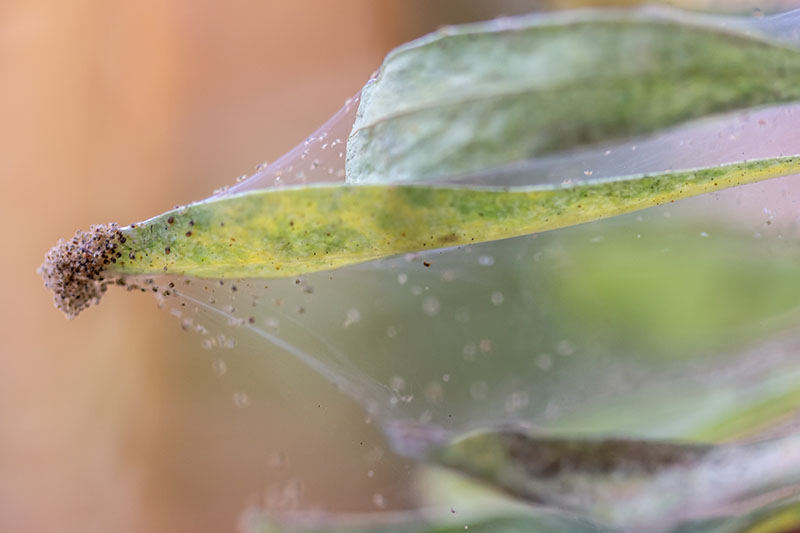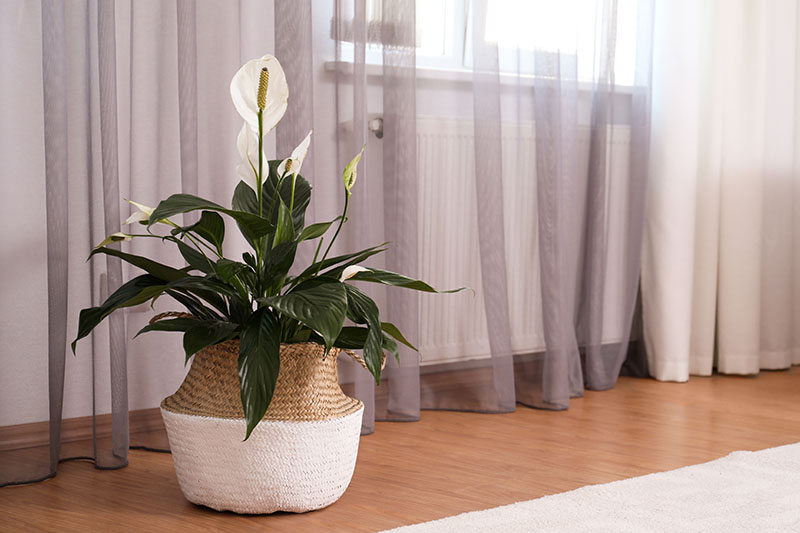I think the combination of columnar central spadix and spathe looks like a candle flame flickering peacefully on a dark night. Regardless of what you might think of the name, you have to admit that there’s something gentle and peaceful about the peace lily. We link to vendors to help you find relevant products. If you buy from one of our links, we may earn a commission. If you love houseplants and you want to add a flowering plant with lush green leaves to your indoor space, this guide will tell you everything you need to know. Are you ready to get started?
What Are Peace Lilies?
These beauties are native to parts of the Tropics in Mexico, Central and South America, and Southeast Asia. They thrive outdoors in the warm climates of USDA Hardiness Zones 11 and 12, in Puerto Rico and parts of Hawaii, but they can’t withstand the cold elsewhere in the US or its territories year round.
Instead, you may grow them indoors as houseplants. Temperatures must remain between 65 and 80°F in order for them to thrive. There are a range of nearly 50 different species and dozens of varieties to choose from, but all feature a spathe – a large, pointed bract meant to attract pollinators, and what we might consider the “flower” – and spadix. The spadix is the spur that rises along with the spathe, housing tiny, visually insignificant flowers. Peace lilies bloom in the spring, and the white spathes and straight spadices can last for up to two months.
If you take extra-good care of your houseplant, it might bloom (aka produce a spathe) for you again in the fall. During the winter, it won’t bloom – but the glossy evergreen leaves are attractive year round. And while true lilies are moderately toxic to humans and dogs and highly toxic to cats, Spathiphyllum species are not actually related to lilies, which are members of the Liliaceae family. Spathiphyllum are in the subfamily Monsteroideae of the Araceae family. Calla lilies are also part of the Araceae family, and they’re also not true lilies. Despite the alarming subfamily name, there’s nothing monstrous about peace lilies. The plants are mildly toxic if ingested, causing irritation to the mouth and, potentially, nausea. It’s best to keep them away from kids and pets like cats. Indoor greenery can help to boost your mood, so it’s a great idea to acquire a few new houseplants during the cold and dark winter months. Have I convinced you that you should add one of these to your collection? Keep reading to learn more about these popular plants, and how to care for them.
Cultivation and History
The genus name Spathiphyllum comes from the Greek words for spoon (spath) and leaf (phyllon), referring to the spoon-like spathe. The plant was brought to Europe in the 1870s, by Gustav Wallis, a plant hunter working for James Veitch and Sons in London. One of the species, S. wallisii, is named after him. But each variety shares one defining feature: that spathe. Not all members of the genus go by the common name “peace lily,” but many do. Some of the most popular species among home gardeners include S. cochlearispathum, S. floribundum, S. montanum, and S. wallisii. You can read more about these in the Cultivars and Species section below.
Propagation
You can’t propagate a peace lily from a cutting, and growing it from seed takes years. But thankfully, there’s a reliable and easy way to propagate this type of plant: by division! First, you’ll need to find an existing plant, preferably a mature one with several crowns. Maybe a friend of yours has a Spathiphyllum that could use dividing.
Choose a six to eight-inch pot with drainage holes, and a draining dish to fit beneath it. Using your fingers or a knife, if needed, pry the crown away from the mother plant.
Miracle-Gro Indoor Potting Mix Over a disposable tablecloth or newspapers, gently release the parent plant from its container. Choose a section of crown with at least two leaves and a healthy root system attached. Replace the original lily in her container and add a bit of potting mix if needed. Take your divided crown and plant it in your prepared six to eight-inch pot, tucking the mix in around the roots.
Water thoroughly and place in a location in your home that receives indirect sunlight. And voila! You’re done.
How to Grow
If you bring home a potted plant, it’s easy to transplant it into a larger container. Select a six to eight-inch (or slightly larger, if you prefer) ceramic or plastic pot with drainage holes and a draining tray, and fill it with potting mix. Loosen the edges of the nursery plant with a butterknife, remove it, and replant it in the new container. Peace lilies are famously easy to grow. You’ll want to water the plant about once a week, allowing the top inch of soil to dry out between waterings.
Keep the plant in an area that receives about six to eight hours of filtered or indirect sunlight per day. Peace lilies can tolerate complete shade, but they won’t give you nearly as many flowers if they don’t receive enough indirect sunlight. During the fall and winter, you don’t need to fertilize your plant. This is its time to slow down, grow less vigorously, and rest.
Miracle-Grow Indoor Plant Food I like to use this liquid houseplant fertilizer from Miracle-Gro, available via the Home Depot.
Growing Tips
Make sure your plant receives six to eight hours of indirect sunlight daily. Water about once a week, allowing the top inch of soil to dry out between waterings. Fertilize every month during the spring and summer. No blooms? There are a myriad of reasons why your peace lily may not flower and we explore them here.
Pruning and Maintenance
This easy-care plant doesn’t require any pruning, but do make sure to remove broken or dead leaves when you see them. If a plant becomes rootbound and grows to be too large for its container, transplant it into a larger pot.
Signs that it’s becoming rootbound are: roots beginning to stick out of the drainage holes, water collecting on the surface of the potting mix because it has become too compacted for good drainage, and slowed growth even during the spring and summer. This is also a good time to divide the plant. Take one to three crowns and give them their own new containers, following the directions outlined above. The young plants make excellent gifts for apartment-dwelling friends! If you notice the leaves turning yellow, it’s likely that the plant is receiving too much light, or perhaps not enough of it. Try moving the container to an area near a window if you suspect the latter. If you think it’s receiving too much light, move it a little further away from nearby windows. During the winter, watch out for brown-tipped leaves. Since Spathiphyllum originates in humid rainforests, it stands to reason that these plants don’t like dry winter air. To keep them happy, spray the leaves once or twice a day during the dry days of winter, and once or twice a week during the spring and summer, if humidity levels are low.
Every week, wipe the leaves gently with a damp cloth to remove dust. This will also help keep the leaves healthy and free of pests and disease, and it’s a great task to give the kids in your life. Get them started on plant care early!
Managing Pests and Disease
When they’re grown as houseplants, peace lilies don’t typically fall prey to many varieties of pests or diseases. But there are a few things to watch out for.
S. cochlearispathum
Also known as the Cupido peace lily, – which is Spanish for Cupid – this species is native to southern Mexico and grows to between three and six feet tall, though it will rarely attain such a height except under extremely favorable conditions. A favorite with horticulturists, S. cochlearispathum has been cultivated into many popular varieties. The leaves are long, ribbed, and pointed at the ends.
S. floribundum
Often called the “snowflower,” this species features a green-tinged spathe and narrow, round-tipped, ribbed leaves. Native to northwestern South America, this species and its cultivars can (and often do) grow up to six feet tall.
S. montanum
Native to Panama and Costa Rica, S. montanum sports long, pointed, glossy green, ribbed leaves and a snow-white spadix.
S. wallisii
This popular species has produced dozens of varieties. The botanical name comes from 19th-century German plant collector Gustav Wallis. Many of the cultivars available today are derived from this species.
S. wallisii You can find S. wallisii plants available from Nature Hills Nursery. Available in a range of sizes and colors, now that you’re familiar with four of the most common species, here are three of our favorite Spathiphyllum cultivars to start or expand your houseplant collection:
Domino
For a houseplant that provides extra interest with its unique, pointed, speckled leaves, try S. wallisii ‘Domino.’ With lush green foliage and bright white spathes that rise a foot tall, ‘Domino’ has an alluring effect on anyone who sees it.
‘Domino’ The plant grows and spreads up to two feet tall and wide. You can find it in six-inch containers from Perfect Plants via the Home Depot.
Mauna Loa
This classic cultivar of S. wallisii blooms prolifically in the spring and summer, and grows and spreads up to three feet tall. The white blooms and glossy, lanceolate, deeply ribbed leaves make this a beloved variety all over the world.
Sweet Chico
If you want to grow a peace lily at home but don’t have tons of space, why not try S. wallisii ‘Sweet Chico’? This compact cultivar grows just 14-18 inches tall and spreads 12-16 inches.
‘Sweet Chico’ With arching, lanceolate leaves and slender white spathes, ‘Sweet Chico’ is a perfect addition to any home, large or tiny. Find a four-inch pot containing a live plant online at Burpee. If you notice a strange sticky substance on the leaves, check for aphids. Wipe off the sticky stuff (aka honeydew) and spray the leaves with neem oil to discourage the pests. Soft-bodied, white mealybugs can also bother these plants, leaving cottony webs all over the leaves and stems. Wipe these off, and remove any visible mealybugs – they’re typically about 1/5 of an inch long – and spray the plant with neem oil or insecticidal soap. If you see brown spots, webbing, and dozens of tiny insects on the leaves, you’re probably dealing with spider mites. Remove any damaged leaves, wipe off the webbing, and spray the entire plant with neem oil or insecticidal soap to get rid of them.
If you notice little black insects hopping around, they’re probably just fungus gnats. An infestation is a sign that you’re watering the plant too much, or that the potting mix isn’t draining quickly enough and standing water is attracting the gnats. As for diseases, watch out for pythium root rot caused by the water mold Pythium spp. If the leaves turn yellowish and wilt, and refuse to be revived, take the plant out of its pot and remove any orange, brown, or yellowish roots. Spray the rest of the root system with copper fungicide to help prevent further spread, then sterilize the container and repot in clean soil. You can prevent this disease by not overwatering your plant. Read more about identifying and treating the diseases of peace lilies here.
Best Uses
If you have a young gardener in your life, the peace lily is an ideal first-time houseplant because it is so easy to care for.
Plus, growing peace lilies indoors can brighten long, dreary winters, and potted plants make excellent holiday gifts.
Have you ever grown a peace lily? Please share your stories and questions in the comment section below. In the meantime, check out these articles on growing amazing houseplants next:
Houseplant Primer: A Guide to Basic Care and Durable Plants Add These 5 Nontoxic Houseplants to Your Home Decor ASAP 23 Colorful Houseplants to Warm Up Your Home This Winter
© Ask the Experts, LLC. ALL RIGHTS RESERVED. See our TOS for more details. Product photos via Burpee, Miracle-Gro, Nature Hills Nursery, and Perfect Plants. Uncredited photos: Shutterstock. With additional writing and editing by Allison Sidhu.
